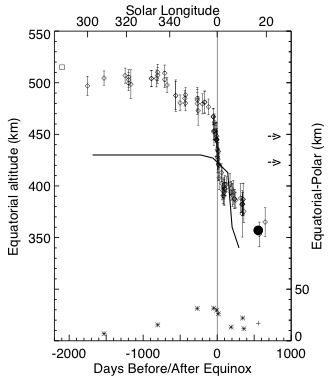2011 Annual Science Report
 NASA Jet Propulsion Laboratory - Titan
Reporting | SEP 2010 – AUG 2011
NASA Jet Propulsion Laboratory - Titan
Reporting | SEP 2010 – AUG 2011
Task 2.1.2.2 Atmospheric Observations
Project Summary
A previously unsuspected seasonal change in the altitude of Titan’s detached haze layer was discovered and used to test current models of the formation of the haze and related dynamical and microphysical processes.
Project Progress
Co-Investigator Robert West, undergraduate J. Balloch, and colleagues measured the altitude of Titan’s detached haze in 81 Cassini ISS images from day 297 (23 October) of 2004 to day 219 (7 August) of 2010, shown in Figure 1 along with two more recent measurements. Both the large amplitude of the altitude oscillation shown in Figure 1 and the precise match of the altitudes of Voyager and Cassini measurements made almost thirty terrestrial years apart are remarkable. They put strong constraints on models of seasonal dynamics and haze formation and beg for a model capable of reproducing this behavior. Three more observational constraints flow from these data. First, the rate of change is greatest at equinox. Second, the haze is observed to be continuous across the south pole. Third, the haze is present at all times before and after equinox observed to date. Some of these constraints (temporal and latitudinal continuity) must be violated at some time in the seasonal cycle to accommodate the reversal in solar heating and the consequent reversal in the flow pattern. If we are fortunate that event will occur under the watchful eye of the ongoing Cassini Solstice Mission.
Two very different models have been proposed to account for the detached haze. The first (Rannou et al., 2002) is a two-dimensional dynamical/haze microphysics model where haze production occurs primarily in the main haze at lower altitude. The detached haze is formed chiefly by advection along streamlines of the meridional circulation. The new observations reported by West et al. (2011) do not reproduce the expected morphology at the summer pole. In the Rannou et al. model the detached haze vanishes as it falls to lower altitude and this is also not observed. A second model by Lavvas et al. (2009) forms the detached haze by a purely microphysical process – it is the location where the small primary particles sedimenting from higher altitudes aggregate to form much larger aggregate particles. This model is a steady state mechanism and does not account for the altitude change. It would need to be coupled with a dynamical seasonal model to do that. New models are needed to account for the seasonal behavior of the detached haze.
References:
Lavvas, P., Yelle, R. V., and Vuitton, V. 2009. The detached haze layer in Titan’s mesosphere. Icarus, 201, 626-633. 10.1016/j.icarus.2009.01.004.
Rages, K., and Pollack, J. B. 1983. Vertical distribution of scattering hazes in Titan’s upper atmosphere. Icarus, 55, 50-62. 10.1016/0019-1035(83)90049-0.
Rannou, P., Hourdin, F., and McKay, C. P. 2002. A wind origin for Titan’s haze structure. Nature, 418, 853-856.
West, R. A., Balloch, J., Dumont, P., Lavvas, P., Lorenz, R., Rannou,P., Ray, T., and Turtle, E. P. 2011. The evolution of Titan’s detached haze layer near equinox in 2009. Geophysical Research Lett., 380, L06204. 10.1029/2011GL046843.

Figure 1. Measurements of Titan’s detached haze seen in Cassini images are shown as a function of time relative to equinox in 2009 (diamonds with error bars). The solid dot is a measurement from Voyager images in 1981 (Rages and Pollack, 1983). The asterisks are equator-pole altitude differences. The solid curve is from the model by Rannou et al. (2002).
Publications
-
West, R. A., Balloch, J., Dumont, P., Lavvas, P., Lorenz, R., Rannou, P., … Turtle, E. P. (2011). The evolution of Titan’s detached haze layer near equinox in 2009. Geophysical Research Letters, 38(6), n/a–n/a. doi:10.1029/2011gl046843
-
PROJECT INVESTIGATORS:
-
RELATED OBJECTIVES:
Objective 1.1
Formation and evolution of habitable planets.
Objective 2.2
Outer Solar System exploration
Objective 3.1
Sources of prebiotic materials and catalysts
